
Original Link: https://www.anandtech.com/show/1218
Consumer Electronics Show 2004 Day 2 - VIA's new Gaming Console
by Anand Lal Shimpi on January 10, 2004 5:09 PM EST- Posted in
- Trade Shows
VIA got their big break a few years ago when Intel failed to deliver the best chipsets to the market for the Pentium III. For the couple of years following, VIA enjoyed tremendous gains in market share which slowed down courtesy of NVIDIA's entry into the chipset market and Intel's lawsuit preventing VIA from producing Pentium 4 chipsets. Although the legal issues have since been resolved, VIA took it upon themselves to transition away from being known as just a chipset manufacturer and towards becoming a platform leader.
Since then we have seen VIA dabble in CPUs, audio and more recently – systems. For the past two years VIA has been talking about building more than just PCs, and just before this Fall's Consumer Electronics Show (CES) VIA began drumming up hype for a possible entry into the gaming console market.
At the start of CES the veil was lifted and VIA's first attempt at a game console stood in the lime light. The internals are all VIA with the system put together and sold by Apex. With many questions remaining about how the console works, we spent some time with both Apex and VIA to shed some more light on the new endeavor.
Introducing the ApeXtreme
Much like the Xbox, the ApeXtreme is basically a PC housed in a consumer electronics-esque chassis. The system comes complete with a motherboard, DVD-ROM drive, hard drive, on-board graphics and DDR SDRAM. Unlike the Xbox however, the ApeXtreme does not try hard to hide its PC ancestry as is made evident by the inclusion of things like a DIMM slot on the motherboard.
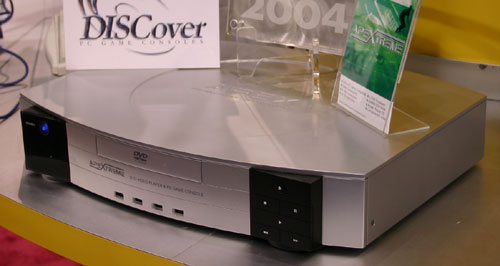
The ApeXtreme runs Windows XP Embedded Edition, although the OS is not physically accessible to the end user (without some hacking). As far as game support goes, the console is designed to run all PC games – we'll get to how that actually works later.
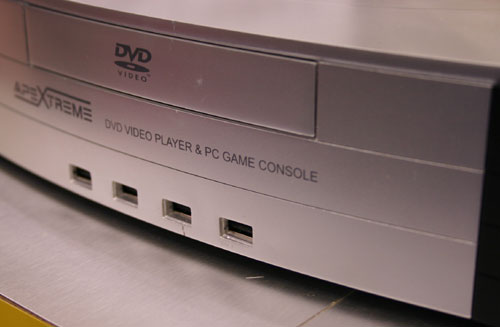
The system features 6 USB ports (much like any present day motherboard), 5.1 channel RCA audio outputs, optical/coax digital audio out, video output in the form of component, S-Video, composite or DVI and topping it all off the ApeXtreme has Ethernet and RJ-11 telephone jacks for Internet/LAN gaming. The full set of inputs and outputs are made possible by the fact that the ApeXtreme is essentially a PC, and neither Apex nor VIA apparently had much desire to mask it.

The system can be controlled via a USB controller or a USB keyboard/mouse. The controllers that were being shown with the ApeXtreme honestly needed some work, but Apex assured us that they were working feverishly to get driver support for all of the popular USB controllers into the shipping version of the ApeXtreme. If the ApeXtreme is going to succeed as a gaming console, support for better controllers is an absolute must. A controller that would integrate keyboard and joystick functionality into the pad is apparently in the works.
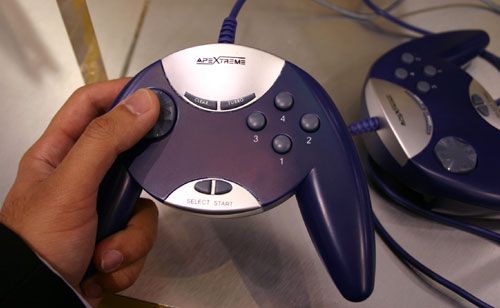
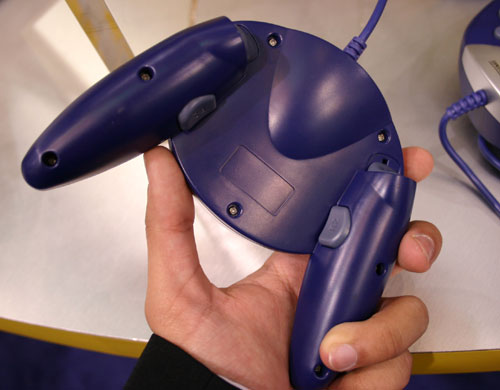
The ApeXtreme is based on VIA's latest 0.13-micron C3 core running at 1.4GHz, although the prototypes now are running at 1.2GHz. The motherboard features VIA's CM400 chipset and a DeltaChrome S8 graphics core. We'll actually have a look at the motherboard later, but now let's get a feel for how this thing works.
How Xtreme are we talking?
As we mentioned before, the ApeXtreme will play any off-the-shelf PC game, but given that the OS is not exposed to the end user how do you install/play the games? The claim of support for any PC game does have one caveat – the game must be supported by a special script that will install/run the game when the disc is inserted. Apex is working on developing scripts for as many games as possible, with around 600 ready right now. The script basically detects the game and handles all of the installation of the game onto the hard drive; the installation process obviously takes a while but once it is complete you can just insert the game disc and you will be able to play the game.
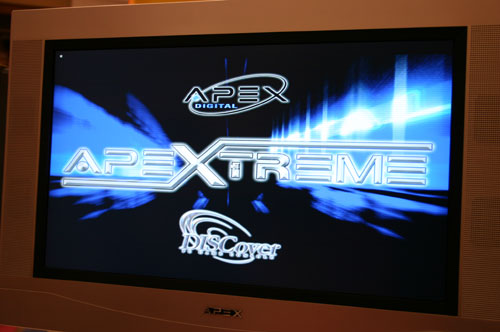
This is the screen that you are greeted with when you power the system on
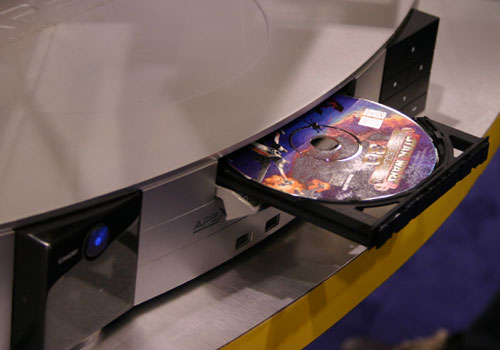
The unit we were playing with already had Star Wars Rogue Squadron installed, so putting the Rogue Squadron disc in the DVD drive resulted in a launcher screen popping up after several seconds.
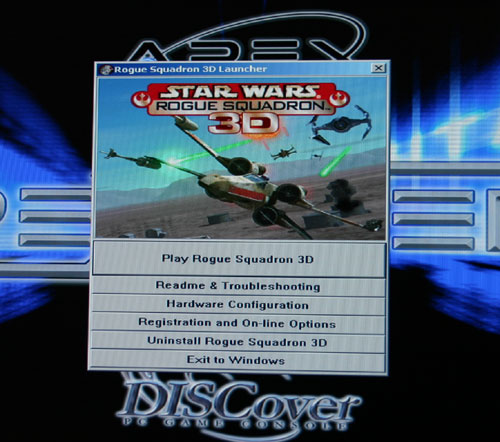
From the launcher screen you can elect to play the game, which will start the game just like double clicking an executable would on a PC. All of the features of the game are available to you by default, meaning you could turn up the resolution, turn off features, reconfigure your controls, etc… Since we're talking about unmodified PC games, a keyboard is pretty much necessary to get the best gaming experience possible, which is why Apex was demonstrating the unit with a wireless keyboard.
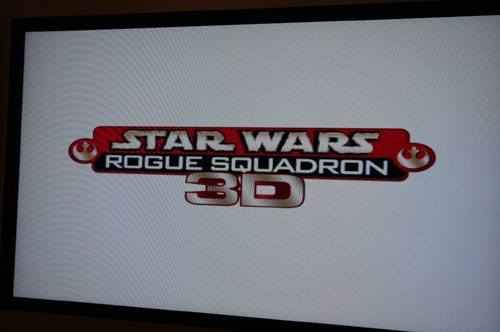
The default resolution the system will run at is 1024x768, while all games will run at their default installed resolution. Remember that since all games have to be installed onto the hard drive just like you would on a PC, the drive can eventually fill up. In the event that there isn't enough room to install a game, the least used game will be deleted in order to make room for the new game. If you decide to go back and play that older game you'll have to go through the same installation process when you insert the older game disc.
Since we are talking about a PC the ApeXtreme could potentially run much more than games, although Apex and VIA are just focusing on games at this point.
Under the Hood
From the specs alone you should realize that we're not talking about a very powerful gaming machine, but if you compare it to the Celeron 733 and the NV2A in the Xbox the system isn't exactly gutless. The motherboard in the ApeXtreme is produced by VIA and occupies the right side of the chassis.
On the motherboard there are three major chips - the VIA C3 processor, the CM400 North Bridge, and the VIA DeltaChrome S8 GPU. The CM400 North Bridge supports up to DDR400 memory, although Apex will determine whether they will use DDR333 or DDR400 memory in the shipping product. The CM400 also features a 200MHz FSB connection to the C3 processor, offering 1.6GB/s of bandwidth between the CPU and North Bridge.
The interesting chip is the VIA DeltaChrome S8 GPU, which is the same GPU that is beginning to ship on add-in cards within a month. The GPU is an 8 pipeline design much like the R300, and features full DirectX 9.0 pixel and vertex shader pipelines. The GPU features support for both 24-bit and 16-bit floating point values in the pixel shader pipeline. The GPU does not have support for the upcoming Pixel Shader 3.0 spec, which is a part of DirectX 9.1. The GPU on the motherboard is clocked at the same speed as the add-in cards at 300MHz, and it can be paired with anywhere from 64 - 256MB of on-board DDR memory.
The current prototype features 64MB of DDR memory on-board although the shipping version may feature more depending on the market price of memory. The memory clock on the desktop DeltaChrome S8 is 300MHz and although it could be that high on the ApeXtreme, the final decision will come closer to the shipping date. The GPU has a single 128-bit memory controller to drive up to 8 chips on the board (the motherboard itself cannot physically accommodate more than 8 chips).
The VIA CM400 chipset does actually have an integrated S3 graphics core that offers significantly less performance than the DeltaChrome S8; an integrated graphics version of the ApeXtreme may eventually be launched as more of a Home Theater PC box but Apex may want to re-evaluate how 'Xtreme' it is after that.
The ApeXtreme is at least a couple of months away from retail availability and during that time a number of the specifications may change. Apex is shooting for a MSRP of $399 for the ApeXtreme at launch.
Final Words
So how does the ApeXtreme play? The two games we saw running were Rogue Squadron and Madden 2004. Rogue Squadron ran fine but Madden 2004 was far from smooth, while we couldn't get confirmation of the resolution it was running at we'd assume either 640 x 480 or 800x600 given the degree of aliasing as you can see in the image below.
As a gaming platform the ApeXtreme is no Xbox or Gamecube killer, or even a competitor. The system provides a decent entry into the PC gaming world as simple sports games, adventure games, Counterstrike and other such titles will play relatively well on the ApeXtreme. VIA's goal of making their way into the living room can very well be fulfilled, but not as a gaming platform rather a home theater platform. If Apex can extend the functionality of the ApeXtreme beyond gaming its attractiveness will increase tremendously, the problem with it right now is that the majority of PC games were not designed to be played in front of a TV with a controller. The other problem Apex will run into is that console games are written to work within the very rigid constraints of console hardware, whereas PC games are not written for a completely uninterrupted gaming experience. Gaming on the ApeXtreme will never be as smooth of a process as on a dedicated console, especially considering the long install times that the majority of games will leave users with. One side effect of the long install times however is that loading times should be reduced significantly as we're talking about having all games installed on the ApeXtreme's hard drive.
The hardware specifications of the ApeXtreme will also limit its success as a long term gaming product; although they are similar to the Xbox specifications, the ApeXtreme is being released over two years after the Xbox. Basically, don't expect the ApeXtreme to have the usual 3 - 5 year console lifespan.
How Apex decides to improve and sell the ApeXtreme will be up to them, but what is important is to note VIA's contribution to the project. VIA's role has become much less of a reference design provider, and more of an end-solution provider. Any manufacturer could buy the VIA motherboard, chipset, GPU and CPU that went into the ApeXtreme and design their own solution. If you aren't happy with the way the ApeXtreme was done the solution is simple - make your own. VIA is doing their best to make that challenge as easy as possible for manufacturers, with a fairly large name like Apex taking the first steps we'd hope that other manufacturers will follow - for VIA's sake at least.
The ApeXtreme won't replace your Xbox and it won't ruin PC gaming, but what it will allow is people without a PC to enjoy PC games. How big of a market we're talking about, only time will tell, but Apex clearly views it as something worth going after. The real story behind the ApeXtreme is VIA's platform, whether it is successful in Apex's case or not doesn't matter - if they fail, another manufacturer can just as easily give it a try.
VIA has finally shown us that they can do much more than just talk about moving beyond the PC, now it's up to them to find the partners to begin to take advantage of the opportunity they have presented. Was this supposed to be easier than competing in the PC market?







